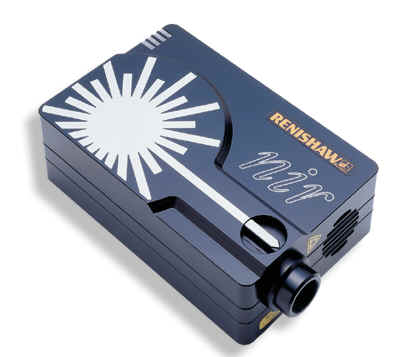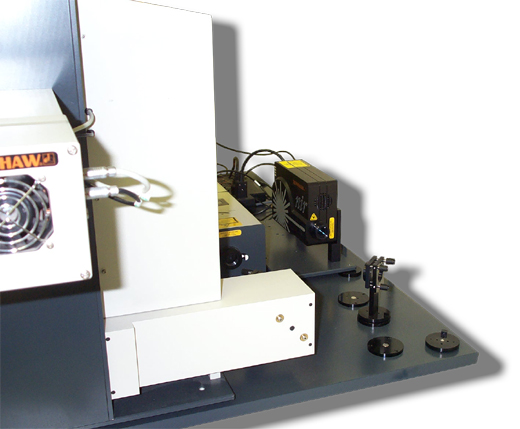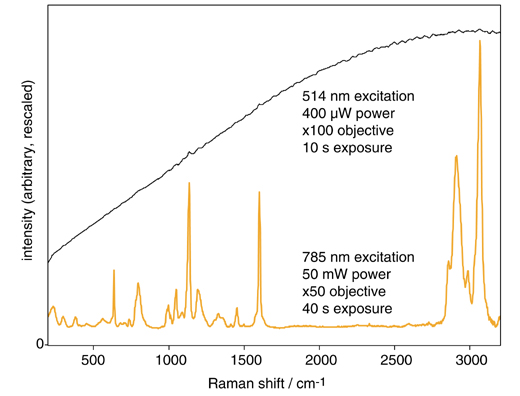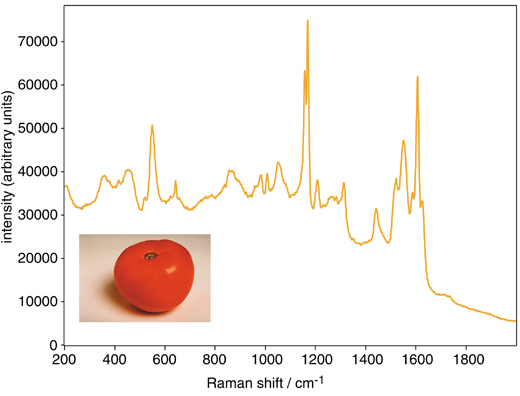New near IR Laser
ANNOUNCEMENTS
 High Powered
High Powered
Near-IR
Excitation Lasers
Introduction
There is a demand for compact, efficient, powerful lasers operating beyond the visible, and particularly in the near infrared region. For example, photoluminescence and Raman spectroscopy often require highly stable, powerful sources in this range. The new Renishaw high power diode lasers, RL785 and RL830, are aimed at meeting this demand.
Design
The RL785 laser produces stabilised output at up to 300 mW at 785 nm. The RL830 similarly generates output at 830 nm. The lasers feature compact design, operating in small cases only 205 mm x 75 mm x 135 mm in length, height, and width, respectively.


All dimensions in mm
The lasers are air-cooled and highly energy efficient, requiring up to 11 W of power at 24 VDC. No separate power supply is needed as this is contained within the package.
Frequency Stability
For spectroscopic use, and particularly in Raman spectroscopy, it is essential that a laser be as nearly monochromatic as possible, i.e. the non-monochromatic emission must be of very low intensity indeed. Further, it is absolutely essential that the laser wavelength (frequency) remains fixed. For example, if the wavelength wanders, so does the whole Raman spectrum, making the measurement of frequency shifts meaningless. The emission from the new lasers is stabilised to within 1 cm-1 and is almost completely free from artefacts.
Emission frequencies explained
In a laser, the possible range of emission frequencies is determined by the gain bandwidth. Gas lasers have very narrow gain bandwidths, owing to the well-defined frequency of atomic transitions in a rarefied gas. For example, a 633 nm HeNe laser has a bandwidth of typically 1 GHz (0.033 cm-1) and cannot emit outside this band no matter what happens in the environment.
Diode lasers have gain bandwidths spanning tens of nanometers, owing to their solid state. In the RL785 and RL830 (as in most stabilised sources for spectroscopy), this unacceptably large gain bandwidth is reined in using optical feedback from a diffraction grating, in an external cavity configuration. The resultant gain bandwidth is approximately 30 GHz (1 cm-1). However, the absolute frequency of the peak gain is not now determined by an atomic transition, but by the thermal stability of the external cavity hardware: when the temperature changes, the gain peak will move, and so will the peak emission wavelength. Thus, the laser temperature is carefully controlled in the RL785 and RL830, and the external cavity and its diffraction grating are housed within the system.
The power advantage
The amount of Raman scattering from a sample dramatically decreases as the excitation wavelength increases, normally resulting in longer spectrum acquisition times or reduced signal-to-noise ratios. Renishaw’s near-IR lasers compensate for this by using higher optical power output levels.
A gas laser for Raman spectroscopy (Ar-ion or HeNe) typically emits about 50 mW of optical power. If a 50 mW 830 nm laser is used instead, the resulting Raman peaks are only about 20% of the intensity (Raman scattering is approximately proportional to l-4). Renishaw’s high power lasers are designed to emit much greater power levels (up to 300 mW), enabling users to acquire high quality spectra rapidly.
Power Output Stability
If intensities of spectral features are of importance to users and/or spectral features are to be measured against backgrounds, the stability of the laser output can be absolutely crucial. Again, this point has been considered and the output is stabilised to within 1%.
Portability
Lasers such as the RL785 and RL830 are attractive in portable instruments because of their small size and weight. To facilitate such uses these sources are available with 24 VDC inputs so that they can be driven by battery power.
Fibre-optic coupling
Fibre-optic coupling between the source and the experiment facilitates a wide range of additional uses. There is often a considerable loss of power when a laser is injected into a fibre and then emitted from the far end, particularly if the beam cross-section is large. Further, there is always a tiny loss along the fibre. Both of these losses tend to be largest with fine fibres, but these new sources are sufficiently powerful that really useful outputs are available through even thin fibres.
|
Fibre core size/µm |
Typical power output/mW |
|
25 |
45 |
|
50 |
160 |
|
62.5 |
180 |
|
100 |
240 |
The results above were obtained using a model 16AC multimode fibre coupler from OZ Optics.
The RL785 & RL830 in use

Figure 1. The new RL785 laser mounted on a
Renishaw RM1000 Raman microscope baseplate.
Renishaw’s RL785 and RL830 lasers operate in the near infrared part of the spectrum. This overcomes most of the fluorescence problems experienced with visible excitation lasers, enabling users to examine successfully a much wider range of samples. Fluorescence suppression is illustrated in Figures 2 and 3.
In Figure 2, the 514 nm (visible) excitation polymer Raman spectrum is masked by the strong fluorescence, whereas the 785 nm spectrum reveals strong, clear peaks with no background. Most biological samples fluoresce strongly because of the copious quantities of natural colourant present. Tomato skin (Figure 3) is a good example; it is impossible to distinguish the Raman peaks using visible excitation, but 830 nm excitation gives a good spectrum.

Figure 2. Raman spectra of poly(sodium 4-styrenesulfonate),
514 nm and 785 nm excitation, Renishaw RM1000
Raman microscope, and x50 objective.

Figure 3. Raman spectrum of tomato skin, 830 nm excitation,
Renishaw RM1000 Raman microscope, x50 objective.
Safety is always important in laser usage. The RL785 and RL830 lasers are Class 3B products and appropriate safety guidelines should always be followed when using them. The laser beam exits the case when the shutter is open and an audible emission warning is built into the system for added safety. The output is essentially parallel and of 6 mm2 cross-section. Although emitting in the near infrared, the intensity is such that it is visible as a deep red glow. It should be stressed that users must only operate these lasers when wearing the appropriate safety goggles.
For more Information, please contact:
Dr K P J Williams
Applications and Marketing Manager
Spectroscopy Products Division
Renishaw plc
Old Town, Wotton-under-Edge, Gloucestershire, GL12 7DW, UK
Direct tel: +44 (0) 1453 523850
Switchboard: +44 (0) 1453 844302
Fax: +44 (0) 1453 844236
Email: ken.williams [at] renishaw.com
Website: www.renishaw.com

